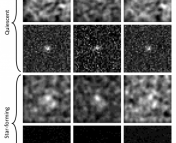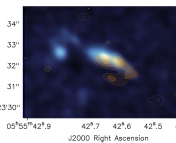Authors: Kimihiko Nakajima, Masami Ouchi, Yuki Isobe, Yuichi Harikane, Yechi Zhang, Yoshiaki Ono, Hiroya Umeda, Masamune Oguri
First Author’s Institution: National Astronomical Observatory of Japan, 2-21-1 Osawa, Mitaka, Tokyo 181-8588, Japan
Status: Submitted to ApJ Supplement [open access]
Key ingredients of the interstellar medium (ISM) in galaxies include gas, dust and metals (here we astronomers mean pretty much everything heavier than Helium). Without metals, it becomes very difficult for gas to cool, condense and form stars (e.g. see this astrobite). On the other hand, metals need stars to form. This cycle forms a cosmic ‘chicken-and-egg’ problem – what came first, and what happens if we wind back the clock to the first stars in the early Universe?
Addressing these questions was very difficult prior to the launch of the James Webb Space Telescope (JWST). In particular, to determine the metallicity of the gas (the relative abundance of heavier elements, e.g. oxygen, to lighter elements, e.g. hydrogen) in star-forming regions we typically require optical emission lines (i.e., the sort of emission we can see with ground-based optical telescopes for nearby galaxies). For galaxies at redshift z > 3 (less than ~ 2 billion years after the Big Bang), these lines are redshifted outside the wavelength range observable from the ground, since the Earth’s atmosphere blocks out most incoming infrared radiation. Being above the atmosphere, and thanks to its high sensitivity, JWST has unveiled deep observations of these lines for galaxies as far back in time as a few hundred million years after the Big Bang. In this paper, the authors have collected spectroscopic and imaging data of 111 galaxies from three of JWST’s major public programs: ERO, GLASS and CEERS. With this data, they have constrained the metallicity, stellar mass and star formation rate (SFR) of these galaxies with redshifts ranging from z = 4-10.
Mass, metallicity, star formation rate… how are these properties connected?
As aforementioned, these properties are very much co-dependent, and are typically described with two relations: the mass-metallicity relation (MZR) and the star formation rate-mass-metallicity relation (SFR-MZR) (e.g. see this astrobite). These relations provide fundamental information on how stellar mass is assembled in galaxies, and how star formation enriches the ISM with metals. In the local Universe, where these relations have been well-studied, we see a clear increase in metallicity with stellar mass (MZR, Figure 2), and we also see trends between the star formation rate, the metallicity and the stellar mass (SFR-MZR, Figure 3). With the necessary data for constraining the relevant properties in hand, the authors of this paper are able to investigate these relations for the high redshift (early) Universe, where the physical properties of the ISM are vastly different to the local Universe.
Determining the metallicity is a tricky business…
The preferred way to determine the metallicity of the gas in a galaxy is via the ‘direct’ method (see this astrobite for an overview of this and other methods). For this method, a specific set of temperature-dependent emission lines, called auroral lines, are necessary. The strength of these auroral lines can be then calibrated to the metallicity, since more metals = more cooling = colder gas. These special lines were detected for the first time at high redshift with observations from the JWST ERO program (follow-up spectroscopy of 4 high redshift galaxies imaged in Figure 1, e.g., Taylor et al. 2022). In today’s paper, the spectra of these galaxies were re-reduced and re-analysed, since previous data reductions were in part based on pre-flight data and contained potential issues.
An additional 5 galaxies from the GLASS and CEERS programs are also found to have good detections of an auroral line, enabling a total of 9 direct method metallicity measurements. However, we still have 102 galaxies left to go. Unfortunately, auroral lines are very faint, and therefore difficult to detect even in many local galaxies. Luckily, researchers have come up with a variety of metallicity calibrations using alternative, stronger emission lines that are detected for the remaining 102 galaxies! The observed ratios of these stronger lines are also found to be correlated to the metallicity of the gas. Even more good news: these calibrations can now be tested at high redshift with the 9 direct method metallicity measurements – and the agreement looks very promising!
High redshift MZR and SFR-MZR
So with the tricky issue of determining the metallicity of high redshift galaxies in the bag, what do we find for the mass-metallicity relation (MZR) and star formation rate-mass-metallicity relation (SFR-MZR) of these 111 galaxies, and how do they compare to nearby galaxies?
Firstly, the metallicity of these high redshift galaxies are found to be lower than in local galaxies. This matches well with expectations: at higher redshift, galaxies tend to be younger so there is less time for stars to enrich the ISM with metals. Secondly, whilst previous studies (pre-JWST, e.g. see this astrobite) have shown a redshift evolution of the MZR from z~0 (local Universe) to z~2-3, no strong evolution is found from z~2-3 to z~4-10 (see Figure 3). This matches predictions from some cosmological simulations (but not all). Further observations and theoretical studies, particularly of low-mass galaxies, will be needed to further investigate the different predictions for this relation.
As for the SFR-MZR, no redshift evolution is found up to z~8 (around 600 million years after the Big Bang), but, interestingly, a significant metallicity drop is found at z>8. What’s happening to the star formation and metal content in galaxies in the very early Universe? The authors note that further observations are needed at high redshift to resolve this mystery. With more and more galaxies being discovered out to redshifts z~10-15, we may not need to wait too long for further insight…
Astrobite edited by Megan Masterson and Alice Curtin
Featured image credit: NASA, ESA, CSA, and STScI.




